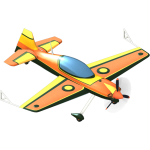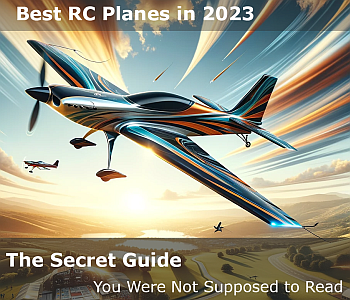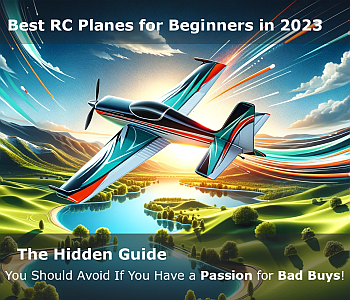Learning to Fly RC Planes – Lesson 7: The Possibilities of Flight
Prerequisites: You have complete mastery of your trainer. You go around again on a landing approach when you realize you are going to have to walk more than 10 meters to retrieve your plane. Most of the time you land within 5-10 meters of yourself. You’ve bought yourself an aileron plane from the list previous.
Objectives: Coming to terms with your new plane, getting your new plane ready to fly, flying it, learning what it can do, and how to stay out of trouble with it and simulator exercises with your new plane.
Coming to terms with your new plane
Contents
So this time, when the instructions said you’ll be flying in 30 minutes (once the battery charges) it’s okay to just go out and fly it? Well, you make your own choices, I would recommend against it. Your aileron plane is going to be very different to your trainer.
And probably the best place to get familiarity with a new plane is in a simulator. Just recapping your simulator options. FMS is a free one but there are plenty of others from quite cheap (like Clearview at $30USD) all the way through to somewhat expensive (like RealFlight at somewhere in the $300-400AUD range). Once you have the sim you need to get a model for it that will vaguely match your plane.
Try and find a model that is kind of close to the aileron model you have chosen, either here or elsewhere. Fly the pants off it in the sim, have fun – do the crazy stuff, but also do the basics like nice clean takeoffs, controlled circuits, and landings. Practice your landings a couple more times, maybe a little more landing practice. Then, grab some other aileron planes and do the same thing. Get a feel for how different aircraft work, from the thin-winged aerobats, through to the low wing warbirds, and the high wing Cessnas etc.
So What’s the Big Deal Anyway?
Ailerons make a plane roll, as does the rudder on a plane with high dihedral wings, so the control does the same thing, so why all the fuss (aka why can’t I have my Spitfire yet)?
Probably the biggest single difference is what happens when you over control the different types of aircraft. A rudder plane with high dihedral self-corrects to a point, and if you go past the 90 degrees (perpendicular to the ground) with the wings it folds over into a stall which is easily recovered from by just putting in up the elevator.
In contrast, if you roll an aileron plane past 90 degrees it doesn’t fall into a stall. It stays at the orientation you put it in, whilst rapidly heading towards the ground. Correction is a two-phase operation – you need to correct the roll (because it won’t do that itself) and then restore level flight. Sometimes, if you are really close to the ground, you need to use down elevator (because the plane is partially inverted) to buy enough time to roll her back. In this situation, you need to make the right call on which way to use the elevator based on whether the plane is upside down or the right way. Go the wrong way, and you nose the plane in hand.
RET (Rudder Elevator Throttle) planes also lose less altitude in corners than REAT (same as RET + Ailerons). By now you should have a pretty well-coordinated rudder/elevator thing happening on corners, so that shouldn’t be so much of an issue for you, but I suppose it is another good reason for beginners who aren’t getting assistance to stay away from REAT planes.
Ailerons also allow you to try many riskier flying maneuvers. No problems provided you plan for them with the usual altitude allowance.
Getting It Together
If you’ve bought an ARF then you need to get her together before flying. Building an aircraft can be quite daunting the first time.
Here are a few hints:
- Light planes fly better. Do everything you can to keep the weight under control. Use glue sparingly, particularly aft of the avionics bay – the tail, in particular, must be as light as possible (the tail is about 4 times as far from the CoG as the nose – any weight at the tail needs to be counterbalanced by 4 times the weight in the nose).
- Be gentle, but don’t be paranoid. Yes planes can be broken easily, and if you break something you may well think that is the end of the model – don’t despair – gravity will probably do far worse things to your model – almost every situation is recoverable.
- Don’t worry about how long it takes you to put together your first ARF – just do it at a speed that you are comfortable with. Normally if you spread the build over a few nights you will get a better result than if you try and do it all in one hit.
- Buy the battery for your plane before/at the same time you buy your aircraft, and make sure the battery fits the compartment before you glue the fuse halves together (if that is how your kit works).
- Look through the instructions a few times before beginning the build.
- Make sure you get your CoG right. I know that adding weight to a plane at the nose feels like drinking a decaf latte with soy milk – it’s just not right – but if she isn’t properly balanced she will be hard to control, and you will probably put her in.
- Try and make the plane as straight as you can. A small plastic set square (like the one you used for geometry at school) and a dressmakers measuring tape will both help in this. It doesn’t have to be perfectly straight to fly well, but by the same token, it is hard for it to be “too” straight.
Flying your new plane
So, let’s start at the end with landing:
Your REAT plane will probably land best when she approaches under power, and lands under power. This may be a significant departure from the way you did things with your trainer.
Most REAT planes are not going to have as low a wing loading as your trainer (see the glossary). This roughly means they will either need to fly faster than your trainer to stay airborne (such as the extrafun/Zero) or will have a high drag wing to create more lift (Tigermoth). In both these cases, for different reasons, having power to land and approach will make things easier.
We talked about how to do powered approaches and landings in part 8, but just to quickly refresh on them:
- Don’t dive below the glide angle, set the throttle so that the aircraft is losing altitude, and use the elevator to push the nose down if she is going too slow and might stall, or pull the nose up if she is going a bit fast.
- Just like a power off approach you flare as you get close to the ground. What you do with the throttle at this stage depends on the approach. If you are going too fast, you can close the throttle. If you are losing altitude too quickly you can add one click of throttle (maybe two – anything more and you are going around). If everything seems just perfect, you can hold the throttle exactly where it is (provided you aren’t belly landing) and close the throttle the instant after she touches the ground.
How your model slows down will depend on the model. The high drag airframes like the Tigermoth will just bleed velocity very quickly once you take the power off. Slicker airframes like the Zero, Extrafun, and Stryker all need time and distance to get rid of airspeed (btw – the Stryker can be glided in for landing power off just like a trainer – don’t bother trying a powered approach with her, it won’t work particularly well (be very careful of your airspeed if you bank with the power off though – if you stall the inner wing you are screwed).
Now, we have often talked about the importance of a good approach to achieving a good landing, without necessarily providing much advice on how a good approach is put together. If you have been flying away from yourself, getting the altitude about right, and then turning 180 degrees to come back and land you haven’t been doing things the easiest possible way because there is already a heck of a lot of “stuff” in these articles). The easiest way to put together a good approach is to fly a three-leg approach – downwind, base, and final. The diagram at the right should explain most of it. There is not a heck of a lot more to say about it except that you will need to experiment with it to get an understanding of the altitude and distance you need for each of your turn points. Practice it some with your trainer and on the sim (don’t plan to do this for the first time on your first flight with your aileron plane). The base leg is the one that will make all the difference to your approaches. Flying the plane across yourself gives you the chance to really get its altitude right without the time pressure you have when the model is flying towards or away from yourself.
Another little thing about landing – you are by now no doubt used to whatever role or other bad behavior your current plane does on approach. Your new plane will have its own new bad habits. You may find on approach for example that you need to feed in some aileron to counteract a roll etc. Unfortunately, sims can’t teach you a whole lot about this. However if you want to get a feel for how hard this can be put your trainer up in the air, and then deliberately put her rudder out of trim, just enough so she gently rolls one way or the other. Now land her. Now take off, put the rudder out of trim the other way, and land her. Nasty isn’t it? Keep at it.
Okay, takeoffs. If you can find a relatively flat piece of dirt, or even better a hard surface like a carpark (with no cars in the middle of nowhere) then I’d say go rolling takeoff. Rolling takeoffs are much better. Not only are they cooler but you have more time, and you don’t need to compensate for mistakes made by the person who hand launches the model.
Rolling takeoffs won’t be new if you had the supercub. If you didn’t there is nothing to worry about. Advance the throttle WOT (you can learn finesse with a throttle for takeoff later), wait until the tail comes up (assuming you have a tail dragger). Feed in a little up elevator. When the wheels lift off use the elevator to give her a modest amount of up pitch but make sure you aren’t’ going to stall her. As per the maiden tips (which you should fully review again – particularly setting rates, checking control throws etc) don’t try to trim the aircraft just after it leaves the ground. Compensate for the bad trim with the control sticks and keep the plane climbing until you have substantial altitude (minimum 20 meters, ideally more like 30 meters) then start trimming.
If you have to hand launch then ideally get an assistant. Ignore what they say about not throwing the plane up – while throwing up too much is a problem, the difference between throwing level, and throwing down is a subtle one. Aim to throw up at about 20 degrees elevation – almost doesn’t matter which plane. Provided there is no danger of anyone losing a finger, throw with 1/2 to WOT. If you have to throw with no throttle then build the throttle up gradually over the space of one second to prevent torque roll.
The plane needs a decent throw, but try to make sure you that the wrist isn’t rolled as the plane is thrown, causing it to start to spiral. If you have to hold the plane behind the wings then use your other hand to support it under the nose (or get your assistant to do that). If you try and just throw it holding it behind the wings the chance of it going straight into the ground (because you are pushing from behind the CoG) is quite high.
When it comes to flying her on your first flight, and all the subsequent flights take the time to learn how she works. Fly her gently and tentatively at first, building up what you ask her to do once you build up your own experience.
Staying Out of Trouble
As alluded to above aileron planes get themselves into different sorts of trouble to RETs (although being too close to the ground remains a universal theme) and need a different approach to recovery. For example, early in my Zero’s career, I busted her up because she had snap rolled onto her back (due to a bad CoG) and I had lost orientation on her. Because she was losing altitude I ended up pulling back on the elevator, which basically made her pull straight into the ground under full power.
The old technique of feeding in a little rudder on the RET is not as effective if we translate it to feeding in aileron on an REAT. Why – because it is symmetrical. If you feed in right aileron the plane doesn’t turn right, it rotates clockwise around the fuselage when looked at from behind. Same for left, except it is counterclockwise. If the plane is upside down, it still rolls exactly the same way. Now an RET plane is in a similar boat to some extent, except when an RET plane is upside down it is obvious – the thing is desperately unstable, and is always trying to fall into a stall that it can recover from into level flight. Apart from losing altitude slightly the REAT plane will probably fly finely inverted.
So you need to focus more on your orientation. If you are confused about whether a plane is inverted or not use *a little* (particularly if you are close to the ground) elevator, and reorient based on the result.
You also need to beat your natural compulsion to pull up when you get into trouble. It served you well on your trainer, but you now need to think more. If you pull up after you accidentally over-roll your aircraft all you will achieve is pulling it around into the ground faster. Aileron planes roll out of trouble. Roll until you are not past the 90-degree point, and then start adding up the elevator. If you don’t have time, then add down elevator while the plane is semi-inverted until you have enough altitude to safely roll out. If you really don’t have time you may want to add down elevator while you roll her to the full inverted position (it’s closer than the upright position yes?) – then once you are safe to roll back to normal flight.
However, the best thing of all is to stick to the strategies that have served you to this point:
- Don’t let the plane get too close to the ground when it is far away and not easy to determine its orientation by sight.
- Have a plan for low altitude work – bring the aircraft down, execute the plan and climb back to a safe cruising altitude (5 metres+).
- Think ahead of the plane particularly if you have a fast model.
- Concentrate on the orientation of your plane. If you lose track of it, what was it doing last time you had a fix on it. Use small elevator inputs to figure out what it is doing.
Simulator Exercises Before You Maiden The New Model:
Fly lots of different aileron planes in FMS or whatever your simulator is. Get a feel for what makes them different. Do plenty of inverted flying (including low-level inverted flying). Make sure you have your orientation figured out with respect to the elevator. Do crazy stuff, do low-level flying – turn your plane upside down and fly it down the runway 1 meter off the deck etc. Keep in mind the planes in a sim tend to fly much better than real life.
Do a dozen victory rolls so that you don’t feel the need to try that on your maiden with your aileron plane, get it all out of your system. You are about to take the next big step – it is going to open a world of possibilities to you but just like when you first started, you need to learn it in stages, and unlike your trainer, your new bird will not be as forgiving.
So, Best of luck




